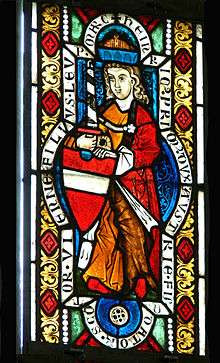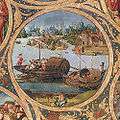Henry II, Duke of Austria
| Henry II | |
|---|---|
|
Duke of Austria, Duke of Bavaria, Count Palatine of the Rhine | |
 Heiligenkreuz Abbey, Lower Austria, c. 1290 | |
| Duke | 1140–1156 |
| Predecessor | Leopold IV |
| Successor | Leopold V |
| Spouse |
Gertrude of Süpplingenburg Theodora Comnena |
|
Issue | |
| Family | House of Babenberg |
| Father | Leopold III, Margrave of Austria |
| Mother | Agnes of Germany |
| Born | 1112 |
| Died |
13 January 1177 Vienna, Austria |
Henry II (German: Heinrich, 1112 – 13 January 1177), called Jasomirgott, was the Count Palatine of the Rhine from 1140 to 1141, the Margrave of Austria from 1141 to 1156, the Duke of Bavaria from 1141 to 1156 as Henry XI, and the Duke of Austria from 1156 to 1177. He was a member of the House of Babenberg.[1]
Life
As the son of Margrave Leopold III, he first became Count Palatine of the Rhine until being appointed Duke of Bavaria and Margrave of Austria when his brother Leopold IV unexpectedly died.
In the course of the dispute between the Welfen and Staufen dynasties in the Holy Roman Empire, the duchy of Bavaria had been taken away from the Welf Henry the Proud by the emperor and given to the Babenberg dynasty. The new Emperor, Frederick I, tried to reach a compromise with the Welfs and endowed the son of Henry the Proud, Henry the Lion, with Bavaria in 1156. A replacement had to be found for the Babenberg family, namely the Privilegium Minus, by which Austria was elevated to a duchy and gained complete independence from Bavaria.
Unlike his father, who resided in Klosterneuburg most of the time, Henry moved his residence to Vienna in 1145. Only by this act could the modern Austrian capital surpass cities such as Krems, Melk or Klosterneuburg. Since then, it has remained the capital of the country. Also in 1147, St. Stephen's Cathedral was completed, which became a visible landmark of the city, showing its prominence. In 1155, Henry founded the Schottenstift monastery in Vienna, in the courtyard of which a statue of him stands to this day.
Until 1143, he was married to Gertrude of Süpplingenburg, the daughter of Emperor Lothair III. In 1148 he married Theodora Comnena, a niece of the Byzantine Emperor Manuel I. Both marriages strongly show the importance of the House of Babenberg in Central Europe in that period.
Henry's brother was the important chronicler Otto of Freising. His sister Judith was the wife of William V of Montferrat.
Henry's nickname, Jasomirgott, was first documented during the 13th century in the form of Jochsamergott, the meaning of which is unclear. According to one theory, it is derived from an Arab word bearing a connection to the Second Crusade where Henry participated in 1146. According to a popular etymology, it is derived from the formula Ja so mir Gott helfe (meaning: "Yes,so help me God").
He was buried in Schottenstift, Vienna.
See also
Gallery
 Babenberger Stammbaum, Klosterneuburg Monastery, 1489–1492
Babenberger Stammbaum, Klosterneuburg Monastery, 1489–1492- Schottenstift, Vienna
 Rathausplatz, Vienna
Rathausplatz, Vienna
References
- Citations
- ↑ Lingelbach 1913, pp. 91–92.
- Bibliography
- Beller, Steven (2007). A Concise History of Austria. New York: Cambridge University Press. ISBN 978-0521478861.
- Brooke, Z. N. (1938). A History of Europe: From 911 to 1198. London: Methuen & Company Ltd. ISBN 978-1443740708.
- Dopsch, Heinz (1999). Österreichische Geschichte 1122-1278. Vienna: Ueberreuter. ISBN 3-8000-3973-7.
- Lechner, Karl (1976). Die Babenberger: Markgrafen und Herzoge von Österreich 976–1246. Vienna: Böhlau. ISBN 978-3205085089.
- Leeper, Alexander W. (1941). History of Medieval Austria. London: Oxford University Press. ISBN 978-0404153472.
- Lingelbach, William E. (1913). The History of Nations: Austria-Hungary. New York: P. F. Collier & Son Company. ASIN B000L3E368.
- Pohl, Walter (1995). Die Welt der Babenberger. Graz: Verlag Styria. ISBN 978-3222123344.
- Rickett, Richard (1985). A Brief Survey of Austrian History. Vienna: Prachner. ISBN 978-3853670019.
- Wegener, Wilhelm (1965). Genealogischen Tafeln zur mitteleuropäischen Geschichte. Vienna: Verlag Degener.
External links
| Wikimedia Commons has media related to Henry II, Duke of Austria. |
| Henry II, Duke of Austria Born: 1107 Died: 13 January 1177 | ||
| Preceded by Leopold the Generous |
Duke of Bavaria 1141–1156 |
Succeeded by Henry the Lion |
| Margrave (Duke) of Austria 1141–1177 |
Succeeded by Leopold the Virtuous | |
| Preceded by William of Ballenstedt |
Count Palatine of the Rhine 1140–1141 |
Succeeded by Herman III of Stahleck |